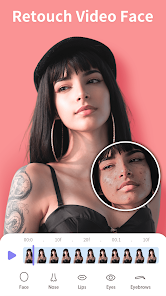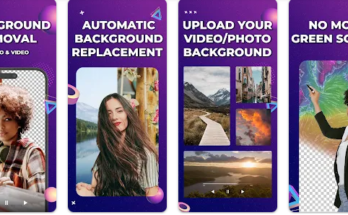How to make any video or photo’s background appear blurry Capturing stunning photos or creating captivating videos often involves more than just pointing and shooting. One essential aspect that can truly elevate your visual content is the background. By intentionally blurring the background, you can draw attention to your subject and create a sense of depth in your images or footage. Whether you’re an aspiring photographer or a videographer looking to level up your skills, learning how to make any video or photo’s background appear blurry is a valuable technique to have in your creative arsenal. In this blog post, we’ll explore various methods, equipment, and editing software options that will allow you to achieve those dreamy blurred backgrounds effortlessly. So grab your camera gear and let’s dive into the world of beautiful bokeh!

The Importance of Background in Photography and Videography
The background in photography and videography plays a crucial role in shaping the overall aesthetic and impact of an image or video. It sets the stage, provides context, and helps to tell a story. A well-chosen background can enhance your subject, while a distracting or cluttered background can take away from the main focus.
When crafting visually appealing content, it’s important to consider how different backgrounds will complement your subject. Are you shooting outdoors with natural scenery as your backdrop? Or are you indoors with a plain wall behind your subject? Each setting offers its own unique possibilities for creating stunning visuals.
In photography, the background can add depth and dimension to an image. By carefully selecting or blurring the background, you can draw attention to specific elements within the frame. This technique is particularly useful when photographing portraits or still life subjects where isolating them from their surroundings creates more visual impact.
In videography, the background has a similar effect on storytelling. A well-planned background can set the mood, convey emotions, or provide additional information about a scene. Consider utilizing blurred backgrounds during interviews or intimate moments to create an atmosphere that draws viewers’ attention directly towards your subject.
Remember that experimenting with different backgrounds allows you to explore various creative possibilities and adds versatility to your work. Whether it’s capturing vibrant landscapes as backdrops for fashion shoots or using simple props against neutral tones for product videos – every element contributes to building compelling visuals that resonate with your audience.
Understanding Depth of Field
Understanding Depth of Field
Depth of field is a fundamental concept in photography and videography that can greatly impact the overall look and feel of your images and videos. It refers to the area in front of and behind your subject that appears sharp and in focus. By manipulating depth of field, you can create a blurry background that helps draw attention to your main subject.
In simple terms, depth of field is influenced by three main factors: aperture, focal length, and distance from the subject. Aperture refers to the size of the lens opening through which light enters. A wider aperture (smaller f-number) results in a shallower depth of field, while a narrower aperture (larger f-number) increases the depth of field.
Focal length also plays a role in determining depth of field. Longer telephoto lenses tend to have a more shallow depth of field compared to wide-angle lenses. Additionally, increasing the distance between your subject and the background can help create more separation and blur.
By understanding these concepts and experimenting with different settings on your camera or smartphone, you can achieve that desirable blurry background effect for both photos and videos. So grab your gear, get out there, and start capturing stunning visuals with beautifully blurred backgrounds!
Equipment Needed for Blurry Backgrounds
When it comes to creating a blurry background in your photos or videos, having the right equipment can make all the difference. While you don’t need to break the bank on expensive gear, there are a few essential tools that can help you achieve that beautiful bokeh effect.
First and foremost, a camera with manual control over settings is crucial. This allows you to adjust key factors like aperture and focus manually, giving you more control over your depth of field.
Next up is a lens with a wide maximum aperture. Lenses with low f-stop numbers (such as f/1.8 or lower) allow more light into the camera sensor, resulting in shallower depth of field and blurrier backgrounds. Prime lenses are often favored for their wider apertures.
If you’re shooting video and want to achieve that dreamy blurred background effect while maintaining smooth motion, consider investing in a stabilizer or tripod. These accessories help reduce camera shake and ensure steady footage even when using larger lenses.
If you’re working indoors or in low-light conditions where natural lighting may be limited, having an external flash or continuous lighting setup can come in handy. These tools provide additional illumination and allow for greater flexibility when capturing those beautifully blurred backgrounds.
Remember, while these equipment options can enhance your ability to create blurry backgrounds, technique and creativity play just as important roles. Experimentation is key – try different setups, angles, and focal lengths until you find what works best for your artistic vision!
Techniques for Creating a Blurry Background:
Techniques for Creating a Blurry Background:
Adjusting Aperture: One of the key techniques to create a blurry background is adjusting the aperture settings on your camera. By using a wide aperture, such as f/2.8 or lower, you can achieve a shallow depth of field that will blur out the background while keeping your subject in focus. This technique works best when shooting with prime lenses which offer wider maximum apertures.
Using a Telephoto Lens: Another way to create an attractive blurry background is by using a telephoto lens. These lenses have longer focal lengths and narrower angles of view, allowing you to isolate your subject and make the background appear more blurred. The compression effect produced by telephoto lenses enhances this blurring effect even further.
Changing Distance and Perspective: Experimenting with distance and perspective can also help you achieve that desired blurry background look. By moving closer to your subject while maintaining some distance between them and the background, you can create more separation and enhance the bokeh effect.
By combining these techniques – adjusting aperture, using a telephoto lens, and changing distance/perspective – you can easily capture stunning photos or videos with beautifully blurred backgrounds that add depth and visual interest to your shots.
Remember, practice makes perfect! Don’t be afraid to experiment with different combinations of these techniques until you find what works best for each situation. With time and experience, creating professional-looking images or videos with blurry backgrounds will become second nature to you!
– Adjusting Aperture
Adjusting Aperture: The Key to Blurring Backgrounds
When it comes to creating a blurry background in your photos or videos, understanding how aperture works is crucial. Aperture refers to the size of the opening in your camera lens through which light passes. It affects both the amount of light that enters and the depth of field in your image.
To achieve a beautifully blurred background, you’ll want to use a wider aperture (lower f-number) such as f/2.8 or lower. This allows for a shallower depth of field, meaning that only a small portion of your image will be in focus while the rest becomes pleasantly blurry.
Keep in mind that adjusting aperture not only impacts background blur but also affects other elements like sharpness and exposure. So, finding the right balance is key. Experiment with different apertures and see what works best for each specific shot.
Additionally, using prime lenses with wide maximum apertures can enhance your ability to create dreamy bokeh effects with stunningly blurred backgrounds. These lenses have fixed focal lengths and typically offer wider apertures than zoom lenses.
Remember, mastering aperture control takes practice and experimentation. Don’t be afraid to play around with different settings until you achieve just the right amount of background blur for your desired artistic effect!
– Using a Telephoto Lens
Using a Telephoto Lens
Another technique for achieving a blurry background in your photos or videos is by using a telephoto lens. A telephoto lens has a longer focal length, which allows you to zoom in on the subject while creating that desired blurred effect.
When using a telephoto lens, it’s important to keep in mind that distance plays a crucial role. The closer you are to the subject and the farther away your background, the more pronounced the blur will be. This is because telephoto lenses compress perspective and create shallow depth of field.
Additionally, choosing the right aperture setting is essential when using a telephoto lens. By selecting a wide aperture (such as f/2.8 or wider), you can further enhance the blurriness of the background while keeping your main subject sharp and in focus.
One advantage of using a telephoto lens for achieving blurry backgrounds is that it allows you to isolate your subject from distracting elements in its surroundings. Whether you’re shooting portraits, wildlife, or sports photography, this technique can add depth and visual interest to your images or videos.
Remember to experiment with different distances, perspectives, and apertures when working with a telephoto lens. Each scenario may require slight adjustments to achieve optimal results. So grab your camera and start exploring this creative method for making any video or photo’s background appear beautifully blurry!
– Changing Distance and Perspective
When it comes to creating a blurry background in your photos or videos, one technique that can significantly impact the depth of field is changing the distance and perspective. By adjusting how far away you are from your subject and the angle at which you capture them, you can achieve stunning results.
One way to change distance is by physically moving closer or farther away from your subject. The closer you are to the subject, the shallower the depth of field will be, resulting in a blurrier background. On the other hand, increasing the distance between yourself and your subject will increase the overall sharpness of both foreground and background elements.
Additionally, playing with perspective can also have a dramatic effect on blurring backgrounds. Shooting from a low angle looking up towards your subject can create an artistic bokeh effect behind them. Conversely, shooting from above can minimize distractions in the backdrop and help isolate your main focal point.
Experimenting with different distances and perspectives allows for creative expression while achieving beautifully blurred backgrounds. So don’t be afraid to move around and explore various angles when capturing those perfect shots!
Editing Software Options for Blurring Backgrounds
Editing Software Options for Blurring Backgrounds
When it comes to blurring backgrounds in your photos or videos, editing software can be a valuable tool. There are several options available that allow you to achieve the desired effect with ease.
One popular choice is Adobe Photoshop, which offers a variety of tools and techniques for creating a blurry background. The “Gaussian Blur” filter allows you to selectively blur specific areas of your image, while the “Lens Blur” filter simulates the natural bokeh effect achieved by shooting with a wide aperture lens.
Another option is Lightroom, also from Adobe. This powerful software provides similar capabilities as Photoshop but in a more streamlined interface. With Lightroom, you can use the Adjustment Brush tool to selectively apply blurring effects to your photo’s background.
For those looking for free alternatives, GIMP (GNU Image Manipulation Program) is an excellent choice. Similar to Photoshop, GIMP offers various filters and brushes that can help you achieve a blurry background in your images.
If you’re working with videos and need editing software specifically designed for this purpose, Adobe Premiere Pro and Final Cut Pro are industry-standard options. These programs offer features like depth masking and motion tracking that enable precise control over blurring effects in video footage.
Remember that regardless of the editing software you choose, practice makes perfect when it comes to achieving realistic-looking blurred backgrounds. Experimenting with different settings and techniques will help refine your skills and create stunning visuals every time!
Tips for Achieving the Best Results
When it comes to achieving the best results in creating a blurry background for your photos or videos, there are a few tips that can help you take your skills to the next level.
It’s important to consider the lighting conditions. Optimal lighting can enhance the overall effect of a blurred background and make your subject stand out even more. Experiment with different angles and positions to find what works best for you.
Pay attention to composition. Consider how elements in the foreground and background interact with each other. Sometimes adjusting your position slightly or changing perspective can create interesting bokeh effects that add depth and visual interest to your images or footage.
Practice patience and be willing to experiment. Achieving a perfectly blurred background takes time and practice. Don’t be afraid to try different techniques, adjust settings on your camera or editing software, and learn from both successes and failures along the way.
Seek inspiration from others in the field. Study renowned photographers or videographers who have mastered this technique. Analyze their work closely and try incorporating some of their techniques into your own style while still maintaining originality.
By following these tips, you’ll be well on your way towards achieving stunning blurry backgrounds that enhance the visual impact of your photos or videos.
Conclusion
Conclusion
Creating a blurry background in your photos and videos can greatly enhance the overall quality and aesthetics. It helps to draw more attention to the subject, creating a sense of depth and professionalism. By understanding the concept of depth of field and using the right equipment and techniques, you can easily achieve this desired effect.
Adjusting aperture is one of the easiest ways to blur the background. By using a wider aperture (lower f-stop), you can decrease the depth of field, resulting in a beautifully blurred background while keeping your subject sharp.
Using a telephoto lens also allows you to create a shallow depth of field by compressing distance between objects. This technique is especially useful for portrait photography or capturing subjects from afar.
Changing distance and perspective is another effective way to achieve a blurry background. By moving closer to your subject while maintaining distance from the background, you can create separation between them, resulting in that sought-after blur.
If you don’t have access to high-end camera equipment or want additional control over blurring backgrounds, editing software options like Adobe Photoshop or Lightroom offer powerful tools for post-processing. These programs allow you to selectively blur specific areas or apply filters that mimic natural bokeh effects.
To get optimal results when aiming for blurry backgrounds:
1. Ensure your subject stands out by choosing an appropriate focal point.
2. Consider lighting conditions as they affect both exposure levels and overall image quality.
3. Experiment with different angles, distances, and perspectives until you find what works best for each situation.
4. Practice using manual mode on your camera rather than relying solely on automatic settings.
In conclusion,
Mastering how to make any video or photo’s background appear blurry may take some time and practice but it will undoubtedly elevate your visual storytelling skills as well as leave viewers captivated by your work. Don’t be afraid to experiment with various techniques mentioned above along with editing software options until achieving desired results! With patience, persistence, and a creative eye, you’ll soon be creating stunning visuals with beautifully blurred backgrounds.



